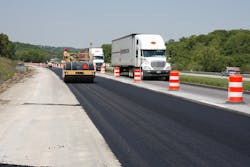A leaked six-page memo that purportedly outlines some of the key principles of the Trump administration’s long-awaited infrastructure plan is drawing fire from several corners of the trucking industry – especially regarding plans to allow states to broaden interstate tolling efforts and commercialize rest stops.
“Our primary concern is that the memo talks about giving states the ‘flexibility’ to toll existing interstates and ‘reconcile the grandfathered restrictions on the use of highway toll revenues with current law.’ We’re gearing up for a big fight over that,” Stephanie Kane, spokesperson for the Alliance for Toll-Free Interstates, told Fleet Owner.
She added that one of her group’s biggest concerns is that the broader use of tolls will shift highway traffic – especially truck traffic – to secondary roads, creating more congestion and potential freight delivery delays.
For example, Kane pointed to a North Carolina Department of Transportation study conducted in 2003 that looked at the impact of placing tolls on I-95 at its northern border with Virginia. That “feasibility study” found that up to 36% of highway traffic would divert around the toll booth location to avoid paying it.
“We feel tolls are a form of underhanded taxation [and this plan] translates to a complete reversal of the current federal ban on tolling existing interstates,” she added. “Tolls are simply a new tax; they are wildly inefficient, sacrificing money that could go toward construction instead going to corporate profits and administrative costs. In addition to the diversion onto secondary roads, which causes congestion and public safety issues, tolls will do unimaginable harm to businesses, as shipping and manufacturing prices skyrocket to account for these new costs.”
The truck stop and travel plaza trade group NATSO is also unhappy with some of the Trump administration’s tolling proposal as well as other aspects of its “privatization” focus on infrastructure funding.
“We urge the administration to refrain from widespread tolling of America’s infrastructure and the commercialization of interstate rest areas,” noted NATSO president and CEO Lisa Mullings in a statement. “It is imperative that the federal government maintain its strong national role in infrastructure development, and not relinquish its responsibility to the states or the private sector.”
Other trade groups, notably the American Trucking Associations (ATA) and the U.S. Chamber of Commerce, are calling for increases in the federal fuels tax as the primary method for funding highway infrastructure improvements.
Chris Spear, ATA’s president and CEO, also voiced his concerned about broadening the use of tolls.
“We commend President Trump for addressing our nation’s infrastructure crisis and making it a top priority of his presidency [but] as we’ve said before, we have serious concerns about the unintended consequences of tolls, including their inefficiency, disruption to traffic flows, diversion to secondary roads and negative impact on local economies, to name a few,” he said in a statement.
“We look forward to working on a legislative package that can deliver the solution our country needs and deserves,” Spear added.
Other key aspects of the Trump administration’s infrastructure memo include:
- Encourage more private and local investment in infrastructure projects through the broader use of federal grants, including the broader use of “advance refunding bonds” to refinance private activity bonds.
- Focus 25% of federal infrastructure appropriations on investment in rural areas.
- Dedicate 10% to a “Transformative Projects Program” under the Commerce Department’s control that would provide “federal funding and technical assistance to projects that cannot obtain private funding.
- Devote 7% of appropriations to expanding federal lending programs to grow investments, with another 5% establishing a “revolving fund” to finance the acquisition of property for infrastructure projects.
About the Author
Sean Kilcarr
Editor in Chief
Sean Kilcarr is a former longtime FleetOwner senior editor who wrote for the publication from 2000 to 2018. He served as editor-in-chief from 2017 to 2018.
